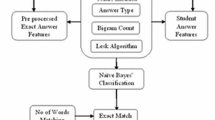Abstract
Student answer script contains different type of answers to be evaluated. The answers may be of objective type answers, subjective type answers, mathematical answers, diagrammatic answers, classification type answers, each of which may require unique approaches for automated evaluation. Classification type answer makes a student to map an answer/object to a particular class/type, like types of grammars, types of normal forms and types of functions. This paper proposes an approach to automate the classification type answers using discrete model which classifies the types of relations in discrete mathematics domain. The proposed approach achieves 100% classification accuracy when compared with other types of classification since the pellet reasoner is used as a classifier which uses predefined classification rules to classify the types of relations.
















Similar content being viewed by others
References
Awan, T.H., Sandnes, F.E.: A tool for automated continuous assessment in numerical methods courses feedback. Int. Conf. Eng. Educ. 21(22), 1–5 (2002)
Yang, J., Li, J., Liu, S.: A novel technique applied to the economic investigation of recommender system. Multimed. Tools Appl. https://doi.org/10.1007/s11042-017-4752-4 (2017)
Xu, Q., Wu, J., Chen, Q.: A novel mobile personalized recommended method based on money flow model for stock exchange. Math. Probl. Eng. (2014) https://doi.org/10.1155/2014/353910
Xu, Q.: A novel machine learning strategy based on two-dimensional numerical models in financial engineering. Math. Probl. Eng. (2013) https://doi.org/10.1155/2013/659809
Li, G., Zhang, Z., Wang, L., Chen, Q., Pan, J.: One-class collaborative filtering based on rating prediction and ranking prediction. Knowl.-Based Syst. 124, 46–54 (2017)
Gai, L.: Pairwise probabilistic matrix factorization for implicit feedback collaborative filtering. Neurocomputing 204, 17–25 (2016)
Palaniappan, S., Krishnamurthi, I.: Register linear based model for question classification using costa level questions. WSEAS Trans. Comput. 14, 369–381 (2015)
Bahmani, A.H., Naghibzadeh, M., Bahmani, B.: Automatic database normalization and primary key generation. In: CCECE, Canadian Conference on Electrical and Computer Engineering, pp. 11–16. IEEE (2008)
Ramamurthy, M., Krishnamurthi, I.: Decision tree based classification type question/answer e-assessment system. Adv. Nat. Appl. Sci. 10(1), 22–25 (2016)
Heumann, B.W.: An object-based classification of mangroves using a hybrid decision tree—support vector machine approach. J. Remote Sens. 3, 2440–2460 (2011)
Santoro, K., Bilisoly, R.: Creating, automating, and assessing online homework in introductory statistics and mathematics classes. JSM 2014-Section on Statistical Education, pp. 1787–1798 (2015)
Su, C.Y., Wang, L.: Construction and analysis of educational assessments using knowledge maps with weight appraisal of concepts. Comput. Educ. 55(3), 1300–1311 (2010)
Richter-Gebert, J., Kortenkamp, U.H.: Interactive Geometry Software’. Cinderella. Version 1.2. User Manual for the Interactive Geometry Software Cinderella. Springer Science & Business Media. Springer, Heidelberg (1999)
Nguyen, M.L., Hui, S.C., Fong, A.C.M.: Probabilistic equivalence verification approach for automatic mathematical solution assessment. In: Proceedings of the Twenty-Third International Joint Conference on Artificial Intelligence, pp. 2028–2034 (2013)
Nosofsky, R.M.: Relations between exemplar-similarity and likelihood models of classification. J. Math. Psychol. 34(4), 393–418 (1990)
Ilango, S. et.al.: Optimization using artificial bee colony based clustering approach for big data. Cluster Comput. (2018) https://doi.org/10.1007/s10586-017-1571-3
Lehner, W., Albrecht, J., Wedekind, H.: Normal forms for multidimensional databases. In: Proceedings of Tenth International Conference on Scientific and Statistical Database Management, pp. 63–72. IEEE (1998)
Cai, Y., Cercone, N., Han, J.: An attribute-oriented approach for learning classification rules from relational databases. In: Proceedings on sixth international conference on Data Engineering, pp. 281–288 (1990)
Nabi, S.A., Rasool, S., Premchand, P.: Detection and extraction of videos using decision trees. Int. J. Adv. Comput. Sci. Appl. 2(12), 147–151 (2011)
Hui, Y., Rongqun, Z., Li, X.: Extracting wetland using decision tree classification. In: WSEAS International Conference Proceedings Mathematics and Computers in Science and Engineering, World Scientific and Engineering Academy and Society, vol. 8, pp. 240–245 (2009)
Sugumaran, V., Muralidharan, V., Ramachandran, K.I.: Feature selection using decision tree and classification through proximal support vector machine for fault diagnostics of roller bearing. Mech. Syst. Signal Process. 22(2), 930–942 (2002)
Fan, C.Y., Chang, P.C., Lin, J.J., Hsieh, J.C.: A hybrid model combining case-based reasoning and fuzzy decision tree for medical data classification. Appl. Soft Comput. 11(1), 632–644 (2011)
Exarchos, T.P., Tsipouras, M.G., Exarchos, C.P., Papaloukas, C., Fotiadis, D.I., Michalis, L.K.: A methodology for the automated creation of fuzzy expert systems for ischaemic and arrhythmic beat classification based on a set of rules obtained by a decision tree. Artif. Intell. Med. 40(3), 187–200 (2007)
Geurts, P., Fillet, M., De Seny, D., Meuwis, M.A., Malaise, M., Merville, M., P, Wehenkel, L.: Proteomic mass spectra classification using decision tree based ensemble methods. Bioinformatics 21(14), 3138–3145 (2005)
Vogrinčič, S., Bosnić, Z.: Ontology-based multi-label classification of economic articles. Comput. Sci. Inf. Syst. 8(1), 101–119 (2011)
De Luca, E.W., Nürnberger, A., Von-Guericke, O.: Ontology-based semantic online classification of documents: supporting users in searching the web. In: Proceedings of the European Symposium on Intelligent Technologies (EUNITE), Aachen, pp. 1–9 (2004)
Rajan, R.H., Dhas, J.P.M.: A method for classification based on association rules using ontology in Web data. Int. J. Comput. Appl. 49(8), 13–17 (2012)
Dongare, Y.V., Dhabe, P.S., Deshmukh, S.V.: RDBNorma: a semi-automated tool for relational database schema normalization up to third normal form. Int. J. Database Manag. Syst. (IJDMS) 3(1), 133–154 (2011)
Demba, M.: Algorithm for relational database normalization up to 3NF. Int. J. Database Manag. Syst. 5(3), 39–51 (2013)
Paul, M., Mather, P.M.: Decision tree based classification of remotely sensed data. In: 22nd Asian Conference on Remote Sensing, pp. 1–20 (2001)
Rosen, K.H.: Discrete Mathematics and Its Applications. Graw Hill, New York (2002)
Qingzhen, X., Li, M.: A new cluster computing technique for social media data analysis. Clust. Comput. (2017) https://doi.org/10.1007/s10586-017-1436-9
Xu, Q., Wang, Z., Wang, F., Li, J.: Thermal comfort research on human CT data modeling. Multimed. Tools Appl. (2017) https://doi.org/10.1007/s11042-017-4537-9
Author information
Authors and Affiliations
Corresponding author
Rights and permissions
About this article
Cite this article
Ramamurthy, M., Krishnamurthi, I., Ilango, S. et al. Discrete model based answer script evaluation using decision tree rule classifier. Cluster Comput 22 (Suppl 6), 13499–13510 (2019). https://doi.org/10.1007/s10586-018-1987-4
Received:
Revised:
Accepted:
Published:
Issue Date:
DOI: https://doi.org/10.1007/s10586-018-1987-4




